TDOA算法原理
TDOA(Time Difference of Arrival)——时间差到达算法,利用了几何数学中双曲线的特点—— 双曲线上的任意点到达两焦点的距离差是固定值。 这个距离差它天然可以抹去用户设备(UE)和基站的之间时钟误差。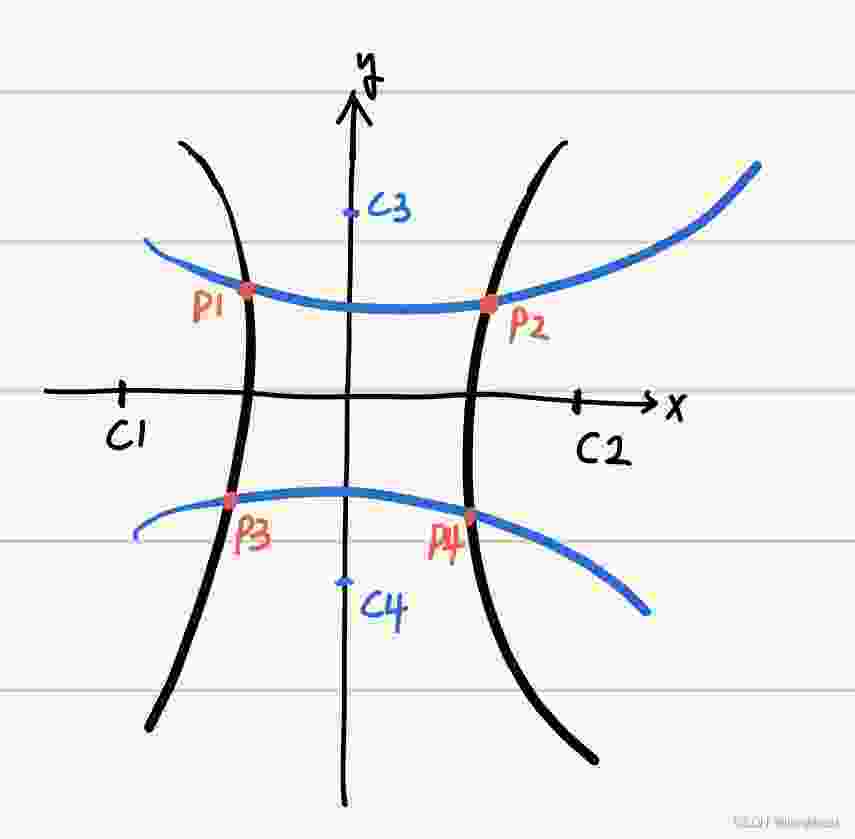
P 1 C 1 = c ⋅ ( t 11 + Δ t ) P_1C_1 = c·(t_{11}+\Delta t) P1C1=c⋅(t11+Δt)其中 Δ t \Delta t Δt是UE和基站之间的钟差(在UE与基站不完全同步的情况下),这个钟差我们没法直接获得。
P 1 C 2 = c ⋅ ( t 12 + Δ t ) P_1C_2 = c·(t_{12}+\Delta t) P1C2=c⋅(t12+Δt) 则 ∣ P 1 C 1 − P 1 C 2 ∣ = c ⋅ ( t 11 − t 12 ) 则|P_1C_1-P_1C_2 |=c·(t_{11}-t_{12}) 则∣P1C1−P1C2∣=c⋅(t11−t12)可见这里的钟差 Δ t \Delta t Δt被消除了,之后使用数学方法求出两个双曲线的焦点。但这同时也暗示着 基站的时钟需要同步才能被消除。 所以TDOA算法特性:UE和基站无需同步,基站之间需要同步,最少三个基站能测得焦点。
Chan算法介绍
在TDOA的解算方法上,有直接求解析解的Chan算法、Fang算法。也有迭代算法如Taylor算法(它是通过不断计算当前误差来调整参数,这个误差需要真实的位置标签来对比,但我们有真实标签后为什么还需要估计呢?这个是我对Taylor算法的疑惑,欢迎大家一起探讨?)。基于解析解的方差理论上是没有误差的,它只受限于计算机的计算精度。
Chan算法公式推导
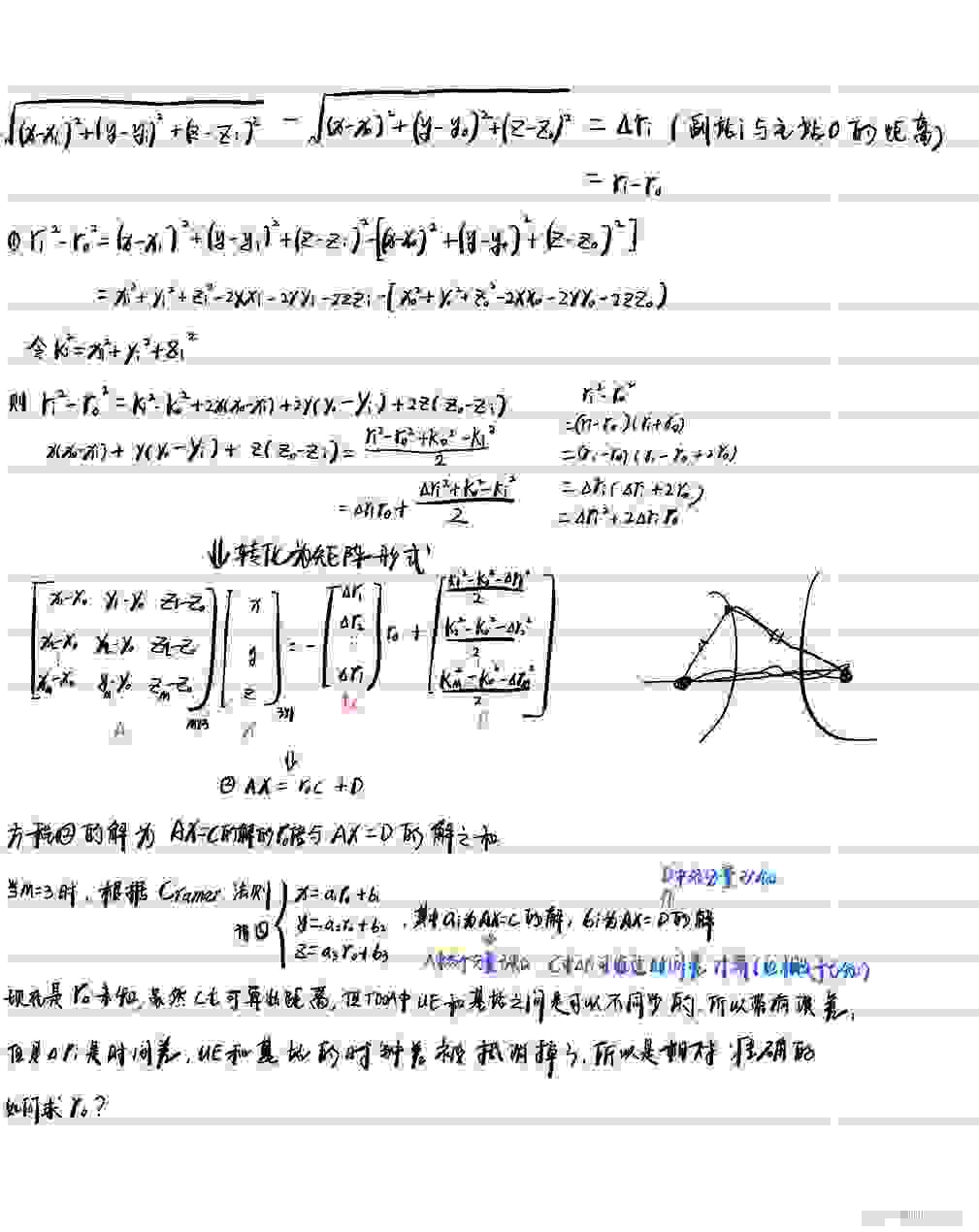
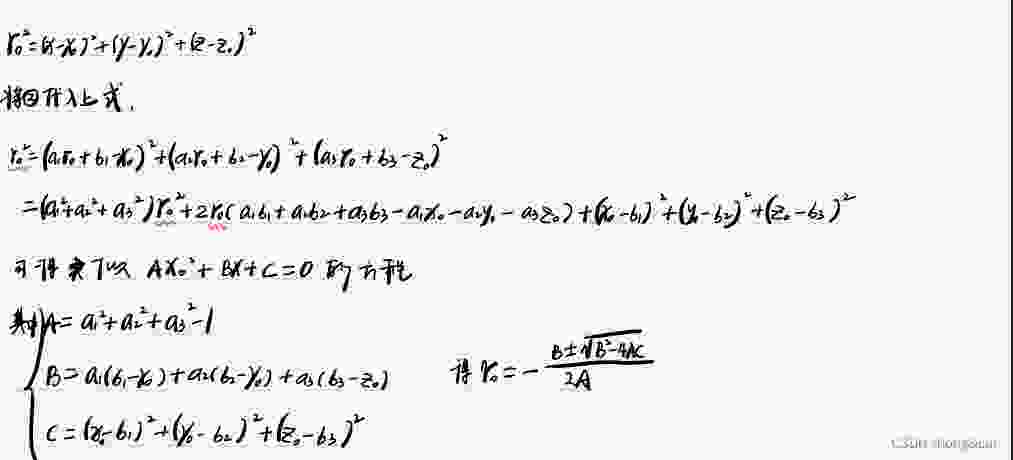
上述算法中, A x = r 0 C + D Ax=r_0C+D Ax=r0C+D,先求 A x = C Ax=C Ax=C的解 x a x_a xa,再求 A x = D Ax=D Ax=D的解 x b x_b xb,再求 r 0 r_0 r0,最后按照 x = r 0 x a + x b x=r_0x_a+x_b x=r0xa+xb组合起来。
Chan算法实现2D
%%clc; clear;close all; format long;figure;%设置UE位置for i=1:100 ue_x = randi(100); ue_y = randi(100); scatter(ue_x, ue_y, '*'); hold on; %注意注意!!!基站的y不能全部相同,否则在第57行的矩阵A第二列元素全为0,Ax=C或Ax=Ds时求不出唯一解 stations = [-40 0; 20 0; 40 50; 10 10]; %第四个基站是为了提出伪解 hold on; r0_real = distance(ue_x, ue_y,stations(1,1), stations(1,2)); r1_real = distance(ue_x, ue_y,stations(2,1), stations(2,2)); r2_real = distance(ue_x, ue_y,stations(3,1), stations(3,2)); r3_real = distance(ue_x, ue_y,stations(4,1), stations(4,2)); %ri_real只是用来计算tds,实际上它会带有时钟误差,而这个误差我们不能直接得到 tds = [r1_real-r0_real r2_real-r0_real, r3_real-r0_real]; position = TDOA(stations, tds); scatter(position(1), position(2), 'o'); hold on;end%%function [position] = TDOA(stations, tds) x0 = stations(1,1);y0 = stations(1,2); x1 = stations(2,1);y1 = stations(2,2); x2 = stations(3,1);y2 = stations(3,2); x3 = stations(4,1);y3 = stations(4,2); r10 = tds(1); r20 = tds(2); r30 = tds(3); %ue对3号基站和0号基站的距离差,真实的 scatter(x0,y0,120,'d', 'filled'); text(x0,y0,'Anchor1'); scatter(x1,y1,120,'d', 'filled'); text(x1,y1,'Anchor2'); scatter(x2,y2,120,'d', 'filled'); text(x2,y2,'Anchor3'); hold on; x10 = x1 - x0; x20 = x2 - x0; y10 = y1 - y0; y20 = y2 - y0; k0 = x0^2 + y0^2; k1 = x1^2 + y1^2; k2 = x2^2 + y2^2; A = [x10 y10; x20 y20]; C = -[r10; r20]; D = [(k1-k0-r10^2)/2; (k2-k0-r20^2)/2]; %求解Ax = r0 * C + D a = A\C; b = A\D; %求解r0 A_ = a(1)^2 + a(2)^2-1; B_ = a(1) * (b(1) - x0) + a(2) * (b(2) - y0); C_ = (x0 - b(1))^2 + (y0 - b(2))^2; if B_^2-A_*C_ < 0 position = [Nan, Nan]; else r0_1 = -(B_+sqrt(B_^2-A_*C_))/A_; r0_2 = -(B_-sqrt(B_^2-A_*C_))/A_; X1 = a * r0_1 + b; X2 = a * r0_2 + b; %剔除错误解:方法一:UE和基站时钟尽量同步。方法二:增加观测站(本例使用) if abs(r30-(distance(X1(1),X1(2),x3,y3)-distance(X1(1),X1(2),x0,y0))) < 1e-8 position = X1; else position = X2; end endend%%function dist = distance(x1,y1,x2,y2) dist = sqrt((x1-x2)^2 + (y1-y2)^2); end上述代码需要注意三个地方!!!
算距离差时,不加上绝对值,这样可以排除掉一半的解(两双曲线相交有2至4个交交点)计算 r 0 r_0 r0时可能有伪解,需要增加观测站或牺牲一定精度来排除另外一个解。(本文是增加了一个基站)。二维定位时,不允许所有的基站在 y y y轴的数值相等。上述代码得到的结果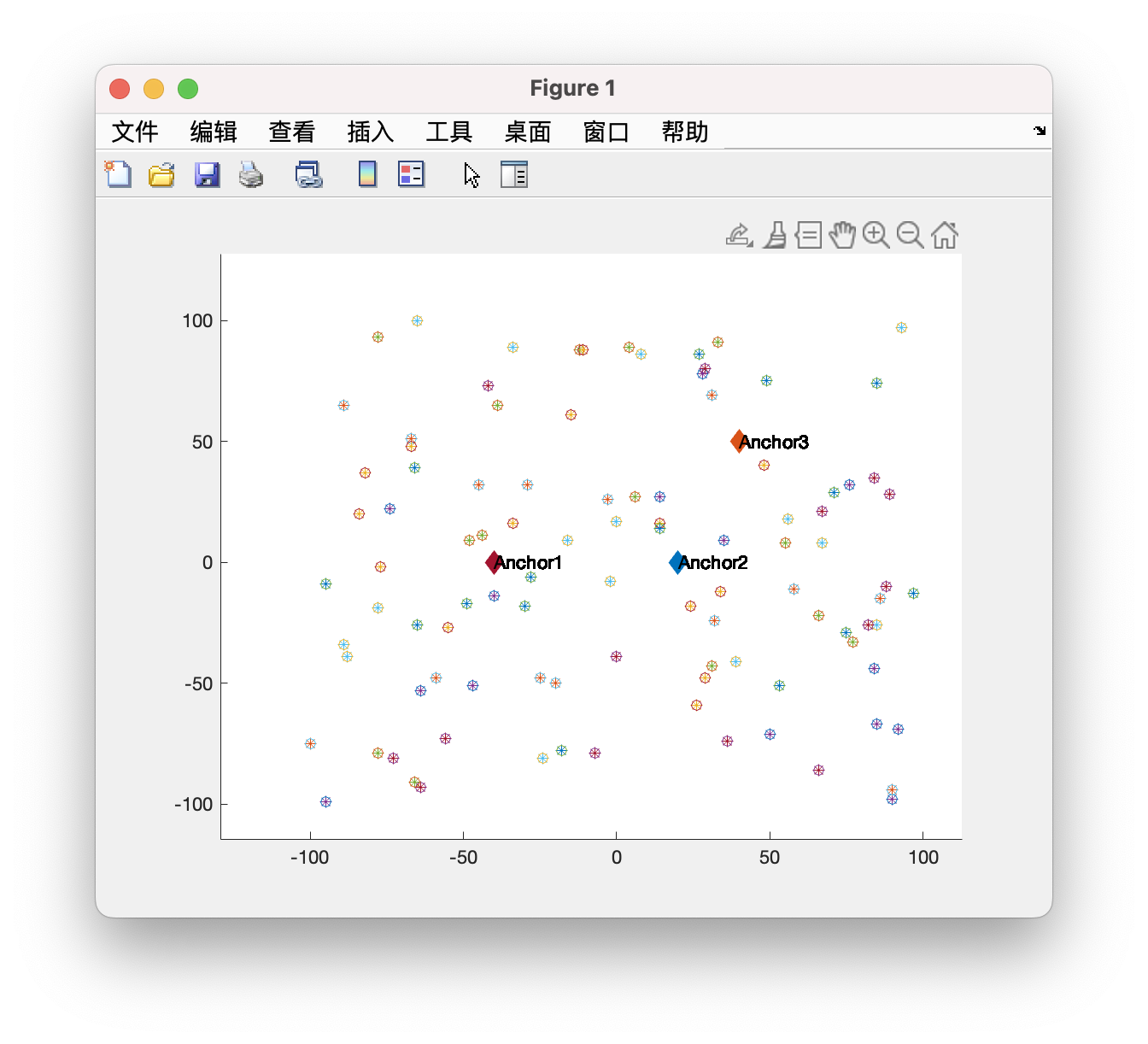
上图中*表示UE的真实位置,o表示UE的计算位置,可以看到每个UE的位置都被正确解算了。
Chan算法实现3D
%%clc; clear;close all;format long; % tmp = unifrnd(0,255,4,2);% x1 = tmp(1,1); y1 = tmp(1,2); % Anchor1% x2 = tmp(2,1); y2 = tmp(2,2); % Anchor2% x3 = tmp(3,1); y3 = tmp(3,2); % Anchor3figure;%随机生成100个UE位置,并对其进行TDOA计算correct_sum = 0;uncorrect_sum = 0;for i=1:100 ue_x = randi(60)+randn(); ue_y = randi(60)+randn(); ue_z = randi(60)+randn(); scatter3(ue_x, ue_y, ue_z, 120, '*'); hold on; %注意注意!!!基站的z不能全部相同,否则在第67行的矩阵A第三列元素全为0,Ax=C或Ax=Ds时求不出唯一解 stations = [-40 0 5; 20 0 15; 40 50 5; 0 0 5; 10 10 10]; r0_real = distance(ue_x, ue_y, ue_z, stations(1,1), stations(1,2), stations(1,3)); r1_real = distance(ue_x, ue_y, ue_z, stations(2,1), stations(2,2), stations(2,3)); r2_real = distance(ue_x, ue_y, ue_z, stations(3,1), stations(3,2), stations(3,3)); r3_real = distance(ue_x, ue_y, ue_z, stations(4,1), stations(4,2), stations(4,3)); r4_real = distance(ue_x, ue_y, ue_z, stations(5,1), stations(5,2), stations(5,3)); tds = [r1_real-r0_real r2_real-r0_real r3_real-r0_real r4_real-r0_real]; position = TDOA(stations, tds); if distance(position(1), position(2), position(3), ue_x, ue_y, ue_z) < 1e-8 correct_sum = correct_sum + 1; else uncorrect_sum = uncorrect_sum + 1; end scatter3(position(1), position(2), position(3), 'o', 'r'); hold on; end%%function [position] = TDOA(stations, tds) x0 = stations(1,1);y0 = stations(1,2);z0 = stations(1,3); x1 = stations(2,1);y1 = stations(2,2);z1 = stations(2,3); x2 = stations(3,1);y2 = stations(3,2);z2 = stations(3,3); x3 = stations(4,1);y3 = stations(4,2);z3 = stations(4,3); x4 = stations(5,1);y4 = stations(5,2);z4 = stations(5,3); r10 = tds(1); r20 = tds(2); r30 = tds(3); r40 = tds(4); scatter3(x0,y0,z0,120,'d', 'filled'); text(x0,y0,z0,'Station1');hold on; scatter3(x1,y1,z1,120,'d', 'filled'); text(x1,y1,z1,'Station2');hold on; scatter3(x2,y2,z2,120,'d', 'filled'); text(x2,y2,z2,'Station3');hold on; scatter3(x3,y3,z3,120,'d', 'filled'); text(x3,y3,z3,'Station4');hold on; hold on; % r21 represents the TDOA between anchor1 and anchor2 % r31 represents the TDOA between anchor1 and anchor3 x10 = x1 - x0; x20 = x2 - x0; x30 = x3 - x0; y10 = y1 - y0; y20 = y2 - y0; y30 = y3 - y0; z10 = z1 - z0; z20 = z2 - z0; z30 = z3 - z0; k0 = x0^2 + y0^2 + z0^2; k1 = x1^2 + y1^2 + z1^2; k2 = x2^2 + y2^2 + z2^2; k3 = x3^2 + y3^2 + z3^2; A = [x10 y10 z10; x20 y20 z20; x30 y30 z30]; C = -[r10; r20; r30]; D = [(k1-k0-r10^2)/2; (k2-k0-r20^2)/2; (k3-k0-r30^2)/2]; %求解Ax = r0 * C + D a = A\C; b = A\D; %求解r0 A_ = a(1)^2 + a(2)^2 + a(3)^2 -1; B_ = a(1) * (b(1) - x0) + a(2) * (b(2) - y0) + a(3) * (b(3) - z0); C_ = (x0 - b(1))^2 + (y0 - b(2))^2 + (z0 - b(3))^2; r0_1 = -(B_+sqrt(B_^2-A_*C_))/A_; r0_2 = -(B_-sqrt(B_^2-A_*C_))/A_; X1 = a * r0_1 + b; X2 = a * r0_2 + b; %剔除错误解:方法一:UE和基站时钟尽量同步。方法二:增加观测站(本例使用) if abs(r40-(distance(X1(1),X1(2),X1(3),x4,y4,z4)-distance(X1(1),X1(2),X1(3),x0,y0,z0))) < 1e-8 position = X1; else position = X2; endend%%function dist = distance(x1,y1,z1,x2,y2,z2) dist = sqrt((x1-x2)^2 + (y1-y2)^2 + (z1-z2)^2); end这份代码是随机生成了100个三维点,然后使用Chan算法解算位置。
上述代码也需要注意三个地方!!!
上述代码的运行结果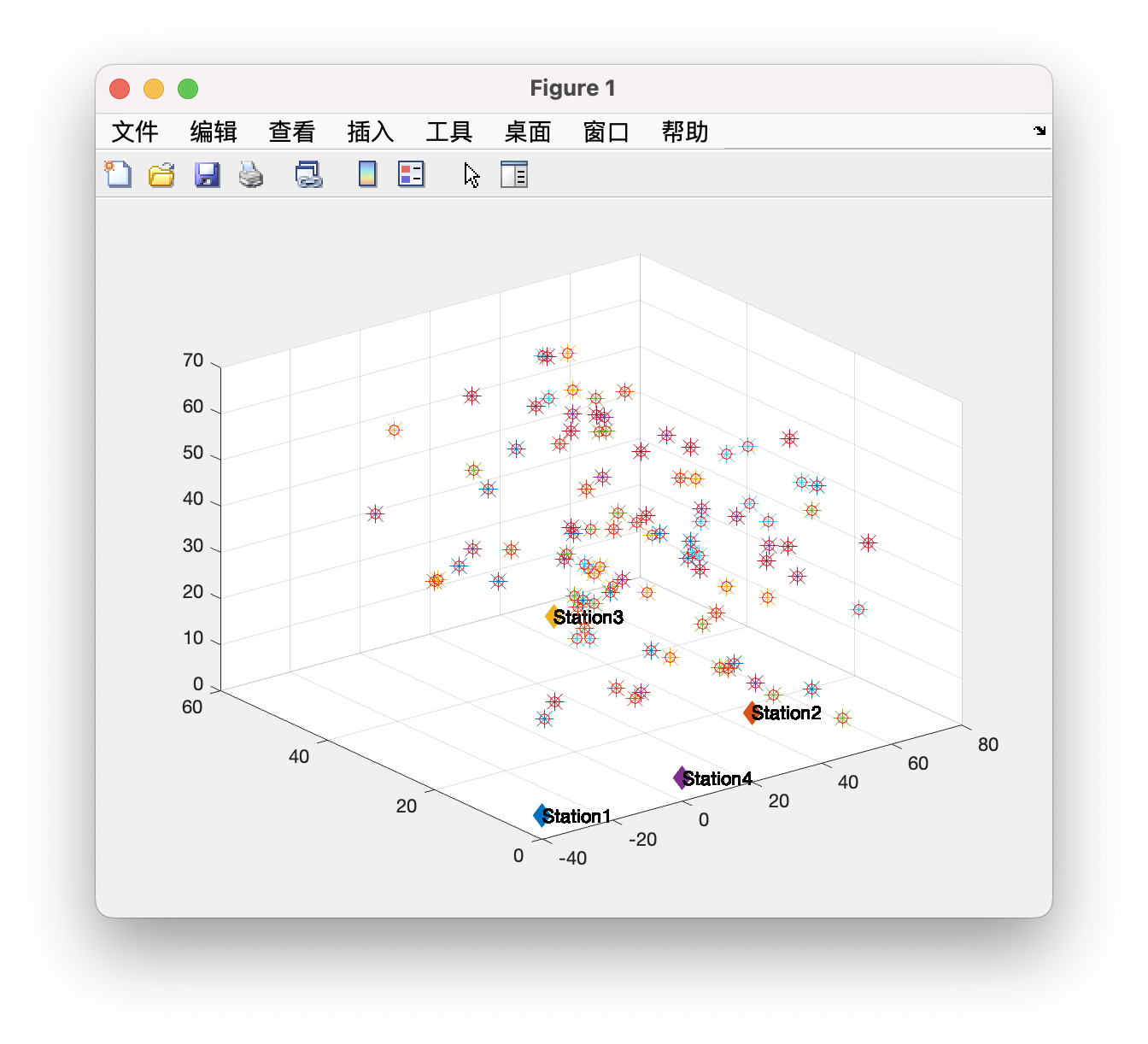
经过测试,所有的解算误差都小于 1 0 − 8 10^{-8} 10−8